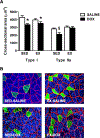Modification of Neuromuscular Junction Protein Expression by Exercise and Doxorubicin
- PMID: 31985575
- PMCID: PMC7901802
- DOI: 10.1249/MSS.0000000000002286
Modification of Neuromuscular Junction Protein Expression by Exercise and Doxorubicin
Abstract
Purpose: Doxorubicin (DOX) is a highly effective antitumor agent widely used in cancer treatment. However, it is well established that DOX induces muscular atrophy and impairs force production. Although no therapeutic interventions exist to combat DOX-induced muscle weakness, endurance exercise training has been shown to reduce skeletal muscle damage caused by DOX administration. Numerous studies have attempted to identify molecular mechanisms responsible for exercise-induced protection against DOX myotoxicity. Nevertheless, the mechanisms by which endurance exercise protects against DOX-induced muscle weakness remain elusive. In this regard, impairments to the neuromuscular junction (NMJ) are associated with muscle wasting, and studies indicate that physical exercise can rescue NMJ fragmentation. Therefore, we tested the hypothesis that exercise protects against DOX-induced myopathy by preventing detrimental changes to key proteins responsible for maintenance of the NMJ.
Methods: Female Sprague-Dawley rats were assigned to sedentary or exercise-trained groups. Exercise training consisted of a 5-d treadmill habituation period followed by 10 d of running (60 min·d, 30 m·min, 0% grade). After the last training bout, exercise-trained and sedentary animals were paired with either placebo (saline) or DOX (20 mg·kg i.p.) treatment. Two days after drug treatment, the soleus muscle was excised for subsequent analyses.
Results: Our results indicate that endurance exercise training prevents soleus muscle atrophy and contractile dysfunction in DOX-treated animals. These adaptations were associated with the increased expression of the following neurotrophic factors: brain-derived neurotrophic factor, glial cell line-derived neurotrophic factor, nerve growth factor, and neurotrophin-3. In addition, exercise enhanced the expression of receptor-associated protein of the synapse and the acetylcholine receptor (AChR) subunits AChRβ, AChRδ, and AChRγ in DOX-treated animals.
Conclusion: Therefore, upregulating neurotrophic factor and NMJ protein expression may be an effective strategy to prevent DOX-induced skeletal muscle dysfunction.
Conflict of interest statement
CONFLICT OF INTEREST
No conflicts of interest, financial or otherwise, are declared by the authors. The results of the present study do not constitute endorsement by ACSM, and are presented clearly, honestly, and without fabrication, falsification, or inappropriate data manipulation.
Figures





Similar articles
-
Effects of short-term endurance exercise training on acute doxorubicin-induced FoxO transcription in cardiac and skeletal muscle.J Appl Physiol (1985). 2014 Aug 1;117(3):223-30. doi: 10.1152/japplphysiol.00210.2014. Epub 2014 Jun 19. J Appl Physiol (1985). 2014. PMID: 24947024 Free PMC article.
-
Glial cell line-derived neurotrophic factor (GDNF) expression and NMJ plasticity in skeletal muscle following endurance exercise.Neuroscience. 2014 Jan 17;257:111-8. doi: 10.1016/j.neuroscience.2013.10.068. Epub 2013 Nov 8. Neuroscience. 2014. PMID: 24215980 Free PMC article.
-
Exercise Training Prevents Doxorubicin-induced Mitochondrial Dysfunction of the Liver.Med Sci Sports Exerc. 2019 Jun;51(6):1106-1115. doi: 10.1249/MSS.0000000000001887. Med Sci Sports Exerc. 2019. PMID: 30629044 Free PMC article.
-
Endurance exercise protects skeletal muscle against both doxorubicin-induced and inactivity-induced muscle wasting.Pflugers Arch. 2019 Mar;471(3):441-453. doi: 10.1007/s00424-018-2227-8. Epub 2018 Nov 13. Pflugers Arch. 2019. PMID: 30426248 Free PMC article. Review.
-
How to Build and to Protect the Neuromuscular Junction: The Role of the Glial Cell Line-Derived Neurotrophic Factor.Int J Mol Sci. 2020 Dec 24;22(1):136. doi: 10.3390/ijms22010136. Int J Mol Sci. 2020. PMID: 33374485 Free PMC article. Review.
Cited by
-
Evaluation of skeletal muscle function in male rats with doxorubicin-induced myopathy following various exercise techniques: the significant role of glucose transporter 4.Pflugers Arch. 2024 May;476(5):797-808. doi: 10.1007/s00424-024-02922-3. Epub 2024 Feb 17. Pflugers Arch. 2024. PMID: 38368293 Free PMC article.
-
Exercise Reduces the Resumption of Tumor Growth and Proteolytic Pathways in the Skeletal Muscle of Mice Following Chemotherapy.Cancers (Basel). 2020 Nov 20;12(11):3466. doi: 10.3390/cancers12113466. Cancers (Basel). 2020. PMID: 33233839 Free PMC article.
-
Targeting Mitochondria and Oxidative Stress in Cancer- and Chemotherapy-Induced Muscle Wasting.Antioxid Redox Signal. 2023 Feb;38(4-6):352-370. doi: 10.1089/ars.2022.0149. Epub 2022 Dec 29. Antioxid Redox Signal. 2023. PMID: 36310444 Free PMC article. Review.
-
Muscle weakness caused by cancer and chemotherapy is associated with loss of motor unit connectivity.Am J Cancer Res. 2021 Jun 15;11(6):2990-3001. eCollection 2021. Am J Cancer Res. 2021. PMID: 34249440 Free PMC article.
-
Long-term Musculoskeletal Consequences of Chemotherapy in Pediatric Mice.Function (Oxf). 2024 Mar 7;5(3):zqae011. doi: 10.1093/function/zqae011. eCollection 2024. Function (Oxf). 2024. PMID: 38706958 Free PMC article.
References
-
- Carter SK. Adriamycin-a review. J Natl Cancer Inst. 1975;55(6):1265–74. - PubMed
-
- Elbl L, Vasova I, Tomaskova I et al. Cardiopulmonary exercise testing in the evaluation of functional capacity after treatment of lymphomas in adults. Leuk Lymphoma. 2006;47(5):843–51. - PubMed
-
- Schwartz AL, Winters-Stone K, Gallucci B. Exercise effects on bone mineral density in women with breast cancer receiving adjuvant chemotherapy. Oncol Nurs Forum. 2007;34(3):627–33. - PubMed
-
- Wright MJ, Halton JM, Martin RF, Barr RD. Long-term gross motor performance following treatment for acute lymphoblastic leukemia. Med Pediatr Oncol. 1998;31(2):86–90. - PubMed
-
- Bonifati DM, Ori C, Rossi CR, Caira S, Fanin M, Angelini C. Neuromuscular damage after hyperthermic isolated limb perfusion in patients with melanoma or sarcoma treated with chemotherapeutic agents. Cancer Chemother Pharmacol. 2000;46(6):517–22. - PubMed
Publication types
MeSH terms
Substances
Grants and funding
LinkOut - more resources
Full Text Sources

